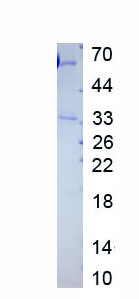Active Glypican 2 (GPC2)
Cerebroglycan; Glypican Proteoglycan 2, Cerebroglycan Proteoglycan; Secreted glypican-2
- Product No.APB585Hu61
- Organism SpeciesHomo sapiens (Human) Same name, Different species.
- Buffer FormulationPBS, pH7.4, containing 5% Trehalose.
- Traits Freeze-dried powder
- Purity> 95%
- Isoelectric Point9.7
- ApplicationsCell culture; Activity Assays.
- DownloadInstruction Manual
- UOM 10µg50µg 200µg 1mg 5mg
- FOB
US$ 250
US$ 625
US$ 1250
US$ 3750
US$ 9375
For more details, please contact local distributors!
ACTIVITY TEST

Glypican 2 (GPC2), a member of glypican (GPC) family genes, produces proteoglycan with a glycosylphosphatidylinositol anchor. Level of the various glypicans changes in a stage and tissue specific manner. Syndecan-2 is expressed in cells of mesenchymal origin, neuronal and epithelial cells, and is the predominant syndecan expressed during embryonic development. Human Syndecan-2 is synthesized as a 201 amino acid (aa) core protein with an 18 aa signal sequence, a 126 aa extracellular domain (ECD), a 25 aa transmembrane region and a 32 aa cytoplasmic tail. The human ECD of Syndecan-2 contains three closely-spaced consensus Ser-Gly sequences for the attachment of HS side chains. It shares 76%, 73%, 87%, 78% and 63% aa identity with the ECD of mouse, rat, bovine, canine and chicken Syndecan-2, respectively. SDC1 has been identified as an interactor of GPC2, thus a functional binding ELISA assay was conducted to detect the interaction of recombinant human GPC2 and recombinant bovine SDC1. Briefly, biotin-linked GPC2 were diluted serially in PBS, with 0.01% BSA (pH 7.4). Duplicate samples of 100 μl were then transferred to SDC1-coated microtiter wells and incubated for 1h at 37℃. Wells were washed with PBST 3 times and incubation with Streptavidin-HRP for 30min, then wells were aspirated and washed 5 times. With the addition of substrate solution, wells were incubated 15-25 minutes at 37℃. Finally, add 50 µl stop solution to the wells and read at 450 nm immediately. The binding activity of recombinant human GPC2 and recombinant bovine SDC1 was shown in Figure 1, the EC50 for this effect is 195.6 ng/mL.
USAGE
Reconstitute in 10mM PBS (pH7.4) to a concentration of 0.1-1.0 mg/mL. Do not vortex.
STORAGE
Avoid repeated freeze/thaw cycles. Store at 2-8°C for one month. Aliquot and store at -80°C for 12 months.
STABILITY
The thermal stability is described by the loss rate. The loss rate was determined by accelerated thermal degradation test, that is, incubate the protein at 37°C for 48h, and no obvious degradation and precipitation were observed. The loss rate is less than 5% within the expiration date under appropriate storage condition.
GIVEAWAYS
INCREMENT SERVICES
-
 BCA Protein Quantification Kit
BCA Protein Quantification Kit
-
 Molecular Mass Marker for Protein
Molecular Mass Marker for Protein
-
 Monoclonal Antibody Customized Service
Monoclonal Antibody Customized Service
-
 Polyclonal Antibody Customized Service
Polyclonal Antibody Customized Service
-
 Protein Activity Test Experiment Service
Protein Activity Test Experiment Service
-
 Electrophoretic Mobility Shift Assay (EMSA) Experiment Service
Electrophoretic Mobility Shift Assay (EMSA) Experiment Service
-
 Buffer
Buffer
-
 Lentivirus Packaging Experiment Service
Lentivirus Packaging Experiment Service
-
 Adenovirus Packaging Experiment Service
Adenovirus Packaging Experiment Service
-
 Real Time PCR Experimental Service
Real Time PCR Experimental Service
-
 Spike RBD Protein (S-RBD)
Spike RBD Protein (S-RBD)
-
 Protein G
Protein G
-
 Protein A
Protein A
| Magazine | Citations |
| Intensive Care Medicine Experimental | Elevated plasma glypicans are associated with organ failure in patients with infection Pubmed: 30618011 |
| Catalog No. | Related products for research use of Homo sapiens (Human) Organism species | Applications (RESEARCH USE ONLY!) |
| RPB585Hu01 | Recombinant Glypican 2 (GPC2) | Positive Control; Immunogen; SDS-PAGE; WB. |
| APB585Hu61 | Active Glypican 2 (GPC2) | Cell culture; Activity Assays. |
| EPB585Hu61 | Eukaryotic Glypican 2 (GPC2) | Positive Control; Immunogen; SDS-PAGE; WB. |
| PAB585Hu01 | Polyclonal Antibody to Glypican 2 (GPC2) | WB; IHC; ICC; IP. |
| MAB585Hu22 | Monoclonal Antibody to Glypican 2 (GPC2) | WB; IHC; ICC; IP. |
| SEB585Hu | ELISA Kit for Glypican 2 (GPC2) | Enzyme-linked immunosorbent assay for Antigen Detection. |
| LMB585Hu | Multiplex Assay Kit for Glypican 2 (GPC2) ,etc. by FLIA (Flow Luminescence Immunoassay) | FLIA Kit for Antigen Detection. |







